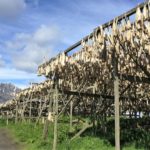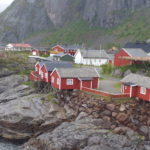StockFish
- By admin
- June 21, 2016
- No Comments
On our second day in the Lofotens we caught a bus to the town of Å, This town is at the end (or beginning) of the main road (E10) through the islands and the last letter in the Norwegian alphabet. It was pouring with rain but the scenery, rather than our dampness, prevailed and with wet weather gear, hats and gloves we wandered around this fishing village that time has little spoilt. The L ofotens enjoy a phenomenon peculiar to these islands of the annual cod breeding season, where cod fish swim from the Barents Sea into the gulf stream around the islands to spawn. Huge amounts of cod have provided the main industry for these islands for many hundreds of years. The fish once caught are gutted and hung out to dry in the air on huge racks that pepper the whole of these islands. The drying takes place mainly between January and April when these dried fish become rock hard. Once dried they are exported all over the world but mainly to Italy, and the heads, which are dried separate
ofotens enjoy a phenomenon peculiar to these islands of the annual cod breeding season, where cod fish swim from the Barents Sea into the gulf stream around the islands to spawn. Huge amounts of cod have provided the main industry for these islands for many hundreds of years. The fish once caught are gutted and hung out to dry in the air on huge racks that pepper the whole of these islands. The drying takes place mainly between January and April when these dried fish become rock hard. Once dried they are exported all over the world but mainly to Italy, and the heads, which are dried separate ly, to Nigeria. The fish are reconstituted by soaking in water and provide a nutritious and, as we found out, delicious food all year round. The dried cod is known as ‘stockfish’ and is sold all over the island and Norway. Stockfish was eaten and traded by the Vikings and according to the Stock Fish Museum the process has little changed. This thriving fishing industry used to see thousands of fishermen come to the Lofotens in January to harvest the cod. These migrant fishermen would stay in the small red wooden huts, known as rorbuer, for the season. Today, it is no longer a seasonal event and has been replaced with a smaller all year round fleet of fishermen, and the rorbuer are now mainly used for tourist accommodation.
ly, to Nigeria. The fish are reconstituted by soaking in water and provide a nutritious and, as we found out, delicious food all year round. The dried cod is known as ‘stockfish’ and is sold all over the island and Norway. Stockfish was eaten and traded by the Vikings and according to the Stock Fish Museum the process has little changed. This thriving fishing industry used to see thousands of fishermen come to the Lofotens in January to harvest the cod. These migrant fishermen would stay in the small red wooden huts, known as rorbuer, for the season. Today, it is no longer a seasonal event and has been replaced with a smaller all year round fleet of fishermen, and the rorbuer are now mainly used for tourist accommodation.

Leave a Reply